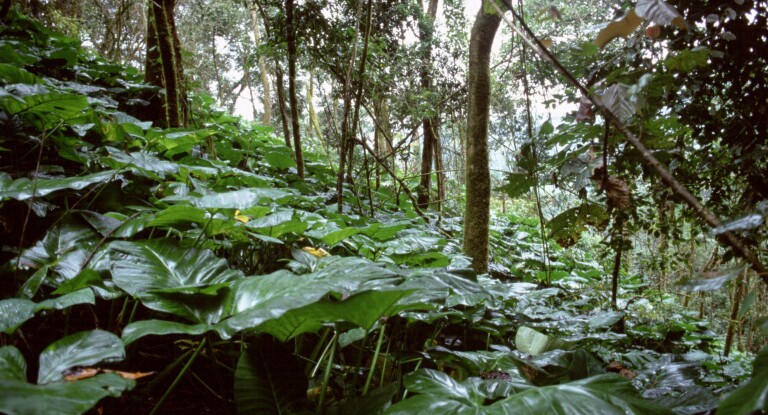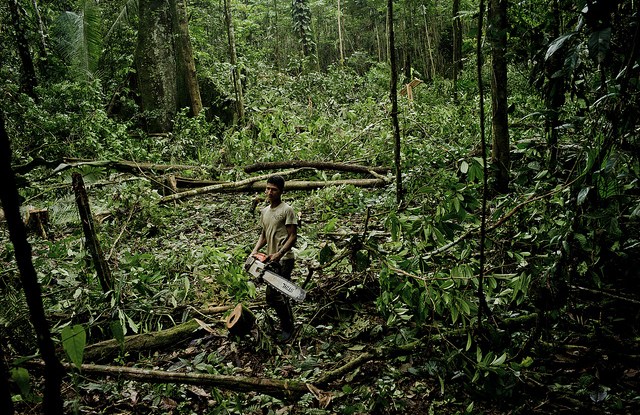
BOGOR, Indonesia—When biologists see a forest, they may think of the number of species it could support.
When climatologists see a forest, they may think of how much carbon it could store.
Rarely, alas, do those points of view meet in a policy context.
But recent research conducted in the Kom-Mengamé forest of southern Cameroon shows that the two disciplines should converge on national parks, nature reserves and other protected areas, where they are likely to find both biodiversity and carbon storage in one place.
“Protected areas in Africa store 49 gigatons of carbon, representing 13.7 percent of continent total,” wrote the authors of a carbon assessment of Kom-Mengamé. “It is clear that these protected areas could play an important role in the mitigation of climate change with the large amount of carbon they store, with associated benefit to biodiversity conservation.”
To illustrate their point, the scientists sampled more than 1,350 plots of forests, swamps and fields across the Kom-Mengamé complex, which combines a gorilla reserve and a national park as well as areas cultivated by local communities.
They measured trees and computed the amount of carbon stored in their trunks and branches.
“On the scale of the complex, the higher the number of tree species, the higher the environment’s ability to store carbon,” said Evariste Fongnzossie, a researcher at the University of Douala and the lead author of the report. Overall, the protected forest and its surroundings were found to store nearly twice as much carbon as the estimated African average.
“It has often been said that the management of protected areas could become part of REDD+”—the proposed international scheme to reduce greenhouse gas emissions caused by deforestation—said Denis Sonwa, a senior scientist at the Center for International Forestry Research (CIFOR) and a co-author of the Kom-Mengamé carbon assessment. “We wanted to show the figures associated with the reality of a given protected area.”
‘PROTECTED AREAS FACE REAL THREATS’
Parks and reserves were historically created to conserve biodiversity, long before carbon emissions became an international issue. Debates have been raging on whether they should be supported as part of efforts to combat climate change: What do we know about the carbon they store? Are they not already protected from deforestation? Would it make any difference to allocate them additional resources?
“The doubts about their additionality were grounded in the absence of data on carbon storage in protected areas,” Fongnzossie said. “This study shows that such doubts are not justified, and that protected areas face real threats of degradation.”
With population growth and pressure for agricultural land intense around many protected areas, the Kom-Mengamé assessment provides useful benchmarks of carbon storage performance in various types of land use, with agricultural fields unsurprisingly achieving the lowest scores.
But it also suggests avenues to help farming communities and nature reserves cohabit in the same landscape: cocoa plantations grown under taller trees, while not as carbon efficient as natural forest, achieved better carbon storage than the African average.
“The structure of such cocoa agro-forestry is close to that of the forest and can serve as a buffer in the management of a protected area,” Sonwa said.
“We are giving an idea of the carbon transfers associated with various changes in land use. This can help the manager of a protected area estimate how its carbon storage will evolve,” he added.
‘CARBON COULD BRING ADDED VALUE’
With such information at their disposal, agencies managing existing parks and reserves could justify how their work contributes to carbon sequestration, while carbon storage could become a criterion when setting the boundaries of new protected areas.
As the Kom-Mengamé forest was logged until 2002, the study also sheds light on the progress achieved in carbon storage when protecting a previously degraded area.
“Carbon could bring added value to biodiversity conservation activities,” said Sonwa—potentially enabling protected areas to access funds allocated for the mitigation of climate change.
International negotiations have begun to integrate both aspects, with discussions on REDD+ and the Aichi targets set by the Convention on Biological Diversity making mentions of each other.
In Cameroon, where the Ministry of Forestry is separate from the Ministry of Environment in charge of biodiversity conservation, integrated approaches could also be beneficial.
But this is easier said than done. While the Kom-Mengamé assessment provides a snapshot of carbon storage in a protected area, its authors acknowledge that the institution of a continuous monitoring, reporting and verification (MRV) scheme would be a first step toward the area being regarded as a serious carbon sink.
For further information about this research, please contact Denis Sonwa at d.sonwa@cgiar.org.
This study was funded by the Jane Goodall Institute/Mengame Gorilla Reserve Project and the Disney Wildlife Conservation Fund.
CIFOR’s research on forests and climate change forms part of the CGIAR Research Program on Forests, Trees and Agroforestry.
We want you to share Forests News content, which is licensed under Creative Commons Attribution-NonCommercial-ShareAlike 4.0 International (CC BY-NC-SA 4.0). This means you are free to redistribute our material for non-commercial purposes. All we ask is that you give Forests News appropriate credit and link to the original Forests News content, indicate if changes were made, and distribute your contributions under the same Creative Commons license. You must notify Forests News if you repost, reprint or reuse our materials by contacting forestsnews@cifor-icraf.org.

